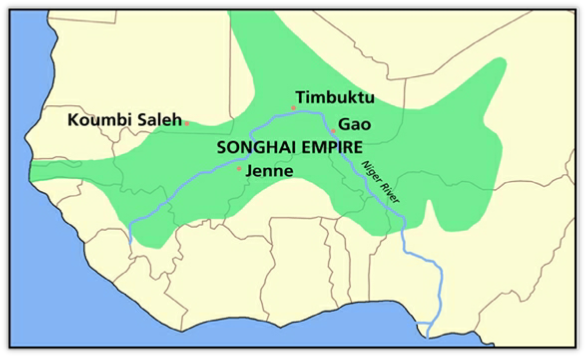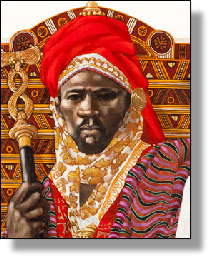


THE SONGHAI EMPIRE -
xxxxxAs we have seen (1324 E2), under Mansa Musa, its most successful leader, the Mali Empire stretched across a vast area of West Africa, and via the city of Timbuktu, commanded the lucrative caravan routes across the Sahara. With his death around 1335, however, the empire went into decline and the Songhai Empire, once subdued by the Mali, slowly reasserted itself. Eventually, in 1464 its able leader Sonni Ali seized Timbuktu and Djénné, another well-
xxxxxIt was in the  1230’s that Sundiata, one of the leaders of the Malinke people in West Africa, won a decisive victory over the Susu clan and took over their ailing kingdom. Within a few years he had consolidated his rule and formed what came to be known as the Mali Empire. In 1240 he razed the capital city of Kumbi Saleh, thus destroying the last vestige of the ancient Kingdom of Ghana. In the space of the next hundred years this empire become one of the largest empires of the day. As we have seen (1324 E2), under Mansa Musa, its most successful ruler, it stretched over modern Senegal, Gambia, Mali and southern Mauritania, and controlled the caravan trade routes which crossed the Sahara via Timbuktu, a thriving commercial city and a centre of Islamic culture. But following the death of Mansa Musa, around 1335, the empire slowly went into decline, its size proving too much for its political and military strength.
1230’s that Sundiata, one of the leaders of the Malinke people in West Africa, won a decisive victory over the Susu clan and took over their ailing kingdom. Within a few years he had consolidated his rule and formed what came to be known as the Mali Empire. In 1240 he razed the capital city of Kumbi Saleh, thus destroying the last vestige of the ancient Kingdom of Ghana. In the space of the next hundred years this empire become one of the largest empires of the day. As we have seen (1324 E2), under Mansa Musa, its most successful ruler, it stretched over modern Senegal, Gambia, Mali and southern Mauritania, and controlled the caravan trade routes which crossed the Sahara via Timbuktu, a thriving commercial city and a centre of Islamic culture. But following the death of Mansa Musa, around 1335, the empire slowly went into decline, its size proving too much for its political and military strength.
xxxxxIt was at this time that the Songhai Empire, once overshadowed by its powerful Mali neighbour, began to re- d the city following the fall of the Mali. Sonni Ali (
d the city following the fall of the Mali. Sonni Ali (
xxxxxAs we shall see (1512 H8), it was left to the next leader, Askia Muhammed I, to conquer the remaining lands once occupied by the Mali and then extend the empire into regions of modern Nigeria. Under his rule the Songhai reached the height of their power, and they remained the dominant force in the area until the coming of the Moroccan army -



Acknowledgements
Map (West Africa): licensed under Creative Commons – en.wikipedia.org. Sonni Ali: detail, date and artist unknown.
E4-